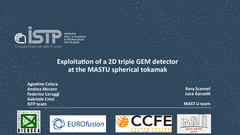Exploitation of a Soft X-Ray 2D triple GEM detector at the MASTU spherical tokamak
ID:92
View Protection:ATTENDEE
Updated Time:2024-10-14 21:16:04
Hits:585
Oral Presentation
Abstract
In the context of magnetic confinement fusion experiments, a Gas Electron Multiplier (GEM)-based
detector has been exploited at the MASTU (Mega Amp Spherical Tokamak) spherical tokamak in the
2023 and 2024 experimental campaigns to study the Soft X-Ray (SXR) radiation (0.1-20keV) emitted
from the plasma. GEM detectors have gained popularity in recent tokamak experiments due to their
resilience in harsh fusion environments compared to traditional semiconductor diodes. Additionally,
they provide energy-resolved SXR emission images with sub-millisecond time resolution, a capability
lacking in diodes. As a result, the adoption of GEM-based detectors has surged in recent years, with
numerous installations on tokamaks like FTU, KSTAR, EAST, and WEST, both as 1D array or 2D
matrices.
The GEM detector presented in this study is installed in front of a beryllium window that acts as a low
energy filter, with a pinhole geometry outside the vacuum chamber. The detector is composed of an
Aluminized Mylar cathode, followed by three GEM foils. It features a 2D readout anode made of a
16x16 matrix of 6mm^2 square pads. The detector integrates custom GEMINI ASICs for signal
readout, allowing photon-counting techniques with Time over Threshold (ToT) analyses on each
detector channel, reaching a total maximum rate of 256 MHz. The gas mixture employed varies
between the two consecutive experimental campaigns: ArCO2 and NeCO2.
Preliminary findings from the 2023 and beginning of 2024 campaigns showcase the effectiveness of
the GEM detector in identifying Magnetohydrodynamic (MHD) instabilities, aligning well with existing
SXR camera data in terms of spatial and temporal resolution. Additionally, the detector offers
spectroscopy capabilities for discerning energy characteristics of plasma events, and the estimation of
the local electron temperature. These results highlight the potential of the GEM-based diagnostic
system in advancing tokamak research, paving the way for comprehensive plasma characterization
and control.




Comment submit